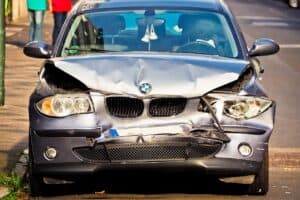Some injuries happen because someone directly did something wrong to cause the crash. Some injuries happen because someone who broke the law pushed another car into you. Other accidents involve a chain reaction that might reach back four, five, or even more drivers before you find the original source. These cases often involve interesting legal questions, and it might surprise you where the fault ultimately lies.
Generally, you cannot be held liable for a chain-reaction accident unless you did something wrong. Car accident cases only hold drivers at fault for a breach of duty – typically a traffic violation. If you did everything right, you can rest assured it wasn’t your fault. However, following too closely and not giving yourself time to stop in an emergency might qualify as a breach. As we go down the chain of who was at fault, each driver can share responsibility for the accident if they did something wrong to help cause it, but there is a legal cutoff point under “proximate causation” rules.
Assigning Fault in Pileups and Chain-Reaction Crashes
Many car accidents involve one driver doing something wrong that then pushes another driver – physically or metaphorically. If they are physically pushed into another car, as was the case in a recent Philadelphia car crash, multiple cars’ occupants might be injured by what the initial driver did. In some cases, you react naturally by swerving, leading you to hit another car, and potentially setting off a chain reaction. In either case, car accident lawyers in Philadelphia and throughout the country ultimately assign blame only to the drivers who did something wrong.
This often means that the first driver who started the chain reaction is at fault for the damages to the rest of the cars involved in the crash, but there are exceptions when the other drivers in the middle also did something wrong.
Following Too Closely
One of the biggest sources of error or mistakes that can lead to liability in these kinds of cases is following too closely/tailgating. If Driver A at the front of a line of cars has to stop in a hurry for a child in the street, then Driver B hits them from behind, Driver B was likely tailgating, which puts them at fault for the crash. If Driver C also hits them from behind, maybe C was too close to B as well – and so on down the chain. Partial fault can be assigned to each at-fault driver to share damages.
At a certain point, if the drivers to the rear were doing everything they were supposed to be doing but still crashed, they cannot be held liable, and some of the drivers in front of them would be at fault instead.
The same is true in the reverse situation where Driver A stops, then Driver B behind them manages to stop before hitting A, but then C rear-ends B and pushes B into A. That crash would be Driver C’s fault for following too closely, but B and A are both victims of C’s mistakes.
Other Reactions
Other chain-reaction crashes occur when a driver hits you, and then you react by swerving or stopping and hit or get hit by someone else. In these cases, we need to look at what is a reasonable reaction from you. If you acted reasonably in reaction to a crash, you are not at fault and the initial driver who hit you is at fault for the third, fourth, etc. drivers’ damages.
For example, if you get hit by a car merging in from your right, it is natural to swerve to your left. If you hit a third car when doing that, it might be the initial driver’s fault, given that you acted normally and reasonably in reaction to the danger. If you did something unreasonable like throw your car in reverse, then you would be responsible for the new accidents you cause; they would not be considered part of the same chain reaction.
Proximate Causation in Chain-Reaction Accidents
There are a few classic legal cases that every law student needs to study dealing with the strange kinds of circumstances that can occur out in the real world. One deals with a package of exploding fireworks knocking equipment on top of a woman trying to board a train, while others deal with railroads sparking fires that take out multiple houses. In any case, the ultimate legal issue comes down to whether a cause is close enough to the end result to qualify as a legal or “proximate” cause of the accident.
For someone to be at fault, we need a negligent act, such as speeding, running a red light, or merging without checking your blind spot. This must be the actual, factual cause of an accident in order to sue for it. This “actual causation” is also known as “but for” causation, given that the accident would not have occurred but for the mistake.
A cause must also be closely related in time and place to the accident to be the “proximate” or legal cause. At a certain point, courts can cut off liability if the driver’s mistakes were too far removed from the resulting chain of events. In most pileups and chain-reaction crashes, the cause is close enough to the end result, even in cases involving 10 or 15 cars. Proximate cause, instead, cuts off fault when something happens a few miles back down the road and cannot reasonably be the legal cause of the crash.
In any chain-reaction crash, it is always best to have a lawyer review your case and help you determine which of the many potential at-fault drivers should be held responsible for your damages. Many of these cases involve complex legal fights, given how blurry the facts are and how many drivers you might need to sue to get all of your damages paid.

